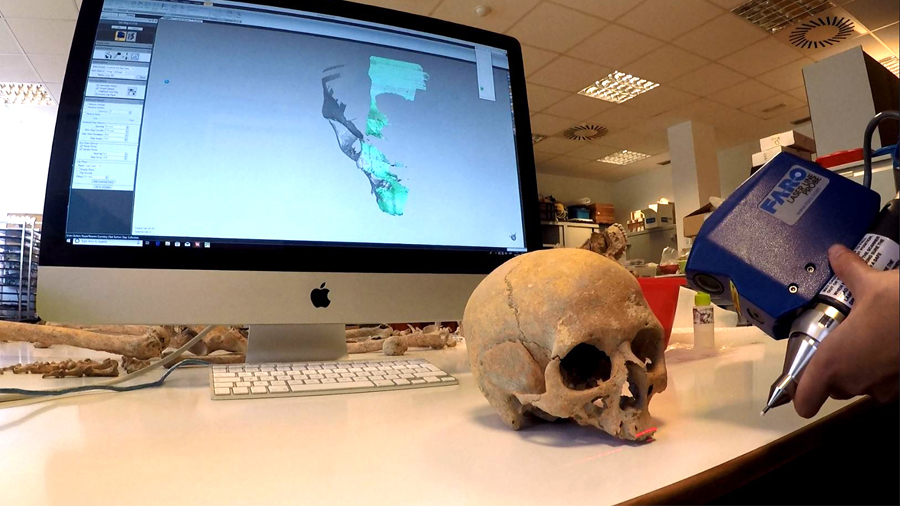Face to face with the prehistoric inhabitants of El Argar
What did the Early Bronze Age men and women of the Argaric culture in the southeastern Iberian Peninsula look like? Researchers at the UAB have analysed the facial features of these individuals based on the digital and biological study of the skulls recovered at the sites of La Almoloya and La Bastida (Murcia), and have obtained images of 40 of their inhabitants. The study, the first to apply this method to such a large group of individuals from the same prehistoric site, is part of a more ambitious project being conducted by the research group on the Argaric society ASOME-UAB, which focuses on kinship relationships in prehistoric times.

Our faces contain information about our family history and lifestyle. For example, certain facial traits can be passed down from parents to children for generations. Is it therefore possible that the physical resemblances among a group of individuals can provide clues about common blood ties?
This is one of the main objectives of a research being carried out by the group of Social and Mediterranean Archaeoecology (ASOME) at the Universitat Autònoma de Barcelona (UAB) on the Argaric society, which expanded throughout the southeastern part of the Iberian Peninsula some 4,000 years ago and was one of the first urban societies in Western Europe. And the first step has been the work of Joana Bruno, researcher at ASOME-UAB, archaeologist and master in science illustration, who was in charge of the facial reconstruction of 38 individuals from El Argar, selected after a detailed osteological study of more than 250 skeletons recovered from well-preserved tombs of La Almoloya and La Bastida.
Display of 12 profiles of reconstructed faces. The individuals present very different profiles, in which the differences in the shape of the nose and chin stand out. The variety in the reconstructed facial features is a reflection of the observable differences in each skull. (Author: ASOME-UAB, license CC BY-NC-ND)
“Unlike the facial reconstructions of individuals from the past that are usually based on artistic inspiration, Bruno's approach applies verifiable scientific procedures”, says Cristina Rihuete Herrada, lecturer of the Department of Prehistory at the UAB and member of ASOME-UAB.
To carry out the study, Joana Bruno digitised the skulls using a high-resolution 3D laser scanner. On the 3D models of the skulls, she added muscle layers and other soft tissues to obtain the most probable appearance of the persons to whom the skulls belonged, in a “complex exercise using forensic techniques and data from the biological profile of these individuals”, says the archaeologist. “The application of the method starts by identifying the biological characteristics of the individual (sex and age) and collecting the measurements of each skull. Subsequently, regression equations are applied to these data to obtain the relative position of the facial features. Soft tissue depths are also added to specific areas of the skull, to determine what would be their most probable appearance”, she adds.
Process of “filling” the face with soft tissue. (Author: ASOME-UAB, license CC BY-NC-ND)
“So far we have the representations of the faces of 22 women, 16 men and two children, mostly all from the site of La Almoloya. This is the largest corpus of facial representations from a single prehistoric site that we have to date, and an unprecedented look at an important part of the community," says Cristina Rihuete.
Kinship Relationships in Prehistory
Joana Bruno’s study, which forms part of her PhD thesis, is integrated in a multidisciplinary research conducted by the ASOME-UAB group, and will be based on medical images and statistical techniques to investigate whether the Argaric facial form retains evidence of kinship and lifestyle. The results of the quantitative comparisons of facial and cranial traits will be contrasted with those of the forthcoming ancient DNA analyses from the same sample, to verify the reliability of the facial approach. “This could lead to a new way of approaching the reconstruction of kinship relationships in prehistoric societies, traditionally ‘invisible’ or hidden from archaeological research”, says Rafael Micó, also researcher at ASOME-UAB.
Based on the phenotypic knowledge of the preliminary DNA analysis and the archaeological data generated by the UAB fieldwork, Bruno is also working on the first artistic "portraits" of the Argarics. "The power of images for the public dissemination of archaeological knowledge is undeniable", says the researcher, for whom "scientific research and artistic work need not be separate fields".